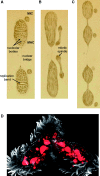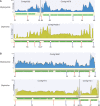The draft assembly of the radically organized Stylonychia lemnae macronuclear genome
- PMID: 24951568
- PMCID: PMC4122937
- DOI: 10.1093/gbe/evu139
The draft assembly of the radically organized Stylonychia lemnae macronuclear genome
Abstract
Stylonychia lemnae is a classical model single-celled eukaryote, and a quintessential ciliate typified by dimorphic nuclei: A small, germline micronucleus and a massive, vegetative macronucleus. The genome within Stylonychia's macronucleus has a very unusual architecture, comprised variably and highly amplified "nanochromosomes," each usually encoding a single gene with a minimal amount of surrounding noncoding DNA. As only a tiny fraction of the Stylonychia genes has been sequenced, and to promote research using this organism, we sequenced its macronuclear genome. We report the analysis of the 50.2-Mb draft S. lemnae macronuclear genome assembly, containing in excess of 16,000 complete nanochromosomes, assembled as less than 20,000 contigs. We found considerable conservation of fundamental genomic properties between S. lemnae and its close relative, Oxytricha trifallax, including nanochromosomal gene synteny, alternative fragmentation, and copy number. Protein domain searches in Stylonychia revealed two new telomere-binding protein homologs and the presence of linker histones. Among the diverse histone variants of S. lemnae and O. trifallax, we found divergent, coexpressed variants corresponding to four of the five core nucleosomal proteins (H1.2, H2A.6, H2B.4, and H3.7) suggesting that these ciliates may possess specialized nucleosomes involved in genome processing during nuclear differentiation. The assembly of the S. lemnae macronuclear genome demonstrates that largely complete, well-assembled highly fragmented genomes of similar size and complexity may be produced from one library and lane of Illumina HiSeq 2000 shotgun sequencing. The provision of the S. lemnae macronuclear genome sets the stage for future detailed experimental studies of chromatin-mediated, RNA-guided developmental genome rearrangements.
Keywords: alternative fragmentation; chromosome copy number; genome rearrangement; histone variant; macronuclear genome; nanochromosome.
© The Author(s) 2014. Published by Oxford University Press on behalf of the Society for Molecular Biology and Evolution.
Figures





Similar articles
-
The Oxytricha trifallax macronuclear genome: a complex eukaryotic genome with 16,000 tiny chromosomes.PLoS Biol. 2013;11(1):e1001473. doi: 10.1371/journal.pbio.1001473. Epub 2013 Jan 29. PLoS Biol. 2013. PMID: 23382650 Free PMC article.
-
Synthesis of pre-rRNA and mRNA is directed to a chromatin-poor compartment in the macronucleus of the spirotrichous ciliate Stylonychia lemnae.Chromosome Res. 2006;14(2):161-75. doi: 10.1007/s10577-006-1033-x. Epub 2006 Mar 17. Chromosome Res. 2006. PMID: 16544190
-
Macronuclear genome structure of the ciliate Nyctotherus ovalis: single-gene chromosomes and tiny introns.BMC Genomics. 2008 Dec 5;9:587. doi: 10.1186/1471-2164-9-587. BMC Genomics. 2008. PMID: 19061489 Free PMC article.
-
Biogenesis of Developmental Master Regulatory 27nt-RNAs in Stylonychia-Can Coding RNA Turn into Non-Coding?Genes (Basel). 2019 Nov 18;10(11):940. doi: 10.3390/genes10110940. Genes (Basel). 2019. PMID: 31752243 Free PMC article. Review.
-
[Stylonychia lemnae as a model organism for studies of macronuclear minichromosomes of the ciliates].Tsitologiia. 2006;48(8):619-35. Tsitologiia. 2006. PMID: 17147253 Review. Russian.
Cited by
-
Nuclear Architecture and Patterns of Molecular Evolution Are Correlated in the Ciliate Chilodonella uncinata.Genome Biol Evol. 2016 Jun 8;8(6):1634-42. doi: 10.1093/gbe/evw099. Genome Biol Evol. 2016. PMID: 27189988 Free PMC article.
-
A comparative in-silico analysis of autophagy proteins in ciliates.PeerJ. 2017 Jan 17;5:e2878. doi: 10.7717/peerj.2878. eCollection 2017. PeerJ. 2017. PMID: 28123910 Free PMC article.
-
Environmental transcriptomics under heat stress: Can environmental RNA reveal changes in gene expression of aquatic organisms?Mol Ecol. 2025 Jul;34(13):e17152. doi: 10.1111/mec.17152. Epub 2023 Oct 4. Mol Ecol. 2025. PMID: 37792902 Free PMC article.
-
Origin, structure and function of millions of chromosomes present in the macronucleus of unicellular eukaryotic ciliate, Oxytricha trifallax: a model organism for transgenerationally programmed genome rearrangements.J Genet. 2015 Jun;94(2):171-6. doi: 10.1007/s12041-015-0504-2. J Genet. 2015. PMID: 26174664 Review. No abstract available.
-
Tetrahymena Comparative Genomics Database (TCGD): a community resource for Tetrahymena.Database (Oxford). 2019 Jan 1;2019:baz029. doi: 10.1093/database/baz029. Database (Oxford). 2019. PMID: 30810209 Free PMC article.
References
-
- Ammermann D. Synthese und Abbau der Nucleinsäuren während der Entwicklung des Makronukleus von Stylonychia mytilus (Protozoa, Ciliata) Chromosoma. 1968;25:107–120. - PubMed
-
- Ammermann D. Morphology and development of the macronuclei of the ciliates Stylonychia mytilus and Euplotes aediculatus. Chromosoma. 1971;33:209–238. - PubMed
-
- Ammermann D, Steinbruck G, von Berger L, Hennig W. The development of the macronucleus in the ciliated protozoan Stylonychia mytilus. Chromosoma. 1974;45:401–429. - PubMed
Publication types
MeSH terms
Substances
Grants and funding
LinkOut - more resources
Full Text Sources
Other Literature Sources
Research Materials
Miscellaneous

